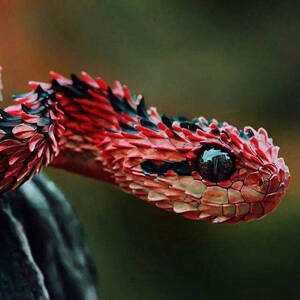Xenopeltis unicolor Reinwardt
IUCN
LCBasic Information
Scientific classification
- name:Xenopeltis unicolor Reinwardt
- Scientific Name:Xenopeltis unicolor Reinwardt,Sun snake, flaming snake
- Outline:Squamata
- Family:G.Aglajidae
Vital signs
- length:32-71cm
- Weight:1-2.5kg
- lifetime:1-3years
Feature
The scales are lustrous and can shine with electric blue, sapphire green, blood red, purple and copper under sunlight.
Distribution and Habitat
In China, it is distributed in Simao, Menglian and Xishuangbanna in southern Yunnan. It was recorded in Guangdong in the past, but it may be a misclassification of Hainan flare snake. It is widely distributed in Sri Lanka, India, Bangladesh, Myanmar, Thailand, Cambodia, Laos, Vietnam, Malaysia, Indonesia and the Philippines. It lives in areas with an altitude of 400-1000m, and lives in caves. It lives in the soft soil of the fields, dead branches and leaves, rotten wood and stones under the trees.
Appearance
There are 2 pairs of parietal scales on the back of the head, surrounded by a single parietal scale in the middle. There are 8 upper lip scales (3-2-3), 2 postorbital scales, 162-196 ventral scales, and 22-31 pairs of subcaudal scales. The back is brown, the ventral surface is grayish white, and the scales on the whole body are shining with metallic luster.
No cheek scales; 1 preorbital scale, 2 postorbital scales; 1+2 temporal scales; 8 upper lip scales, 3-2-3 type; 8 subcaudal scales, the first pair is tangent to the chin scales, and the first 3 scales cut the only pair of chin scales. The dorsal scales are slightly hexagonal, with rounded free edges, and there are 15 rows on the whole body, which gradually increase from the back to the side of the body. The width of the outermost dorsal scales in the middle section is about twice that of the spinal scales, and they are all smooth and without edges; 183 ventral scales in 1 male, 162-193 in females (n=7); anal scales are divided; s
Details
The Latin name of the glitter snake is Xenopeltis unicolor Reinwardt, which belongs to the genus Xenopeltis of the family Xenopeltis.

The glitter snake has a small head and eyes, and its scales are shiny. Under sunlight, it can shine with electric blue, emerald green, blood red, purple red and copper luster, which is why it got its name. The tail is short, and the length of the tail is only about 1/12 of the total body length. The ventral scales are narrow. Its width is less than 3 times that of the adjacent dorsal scales, which is the original characteristic of the glitter snake.
The glitter snake goes out at night to forage, and feeds on snakes, frogs, lizards, small rodents, birds and bird eggs. It is docile and does not bite people actively. If provoked, it can quickly shake its tail. It lays eggs and lays 6-17 eggs.
The glitter snake is not a common pet and is a relatively precious species. The breeder must provide the glitter snake with sufficient temperature and soft soil to facilitate its survival in the burrow. In addition, the glitter snake can only be raised independently and should not be raised together with other animals.
Listed in the 2013 IUCN Red List of Threatened Species ver3.1—Near Threatened (NT).
Listed in the China Biodiversity Red List—Vertebrate Volume, with an assessment level of Vulnerable (VU).
Listed in the second level of the China National Key Protected Wildlife List.
Protect wildlife and eliminate game.
Maintaining ecological balance is everyone's responsibility!








